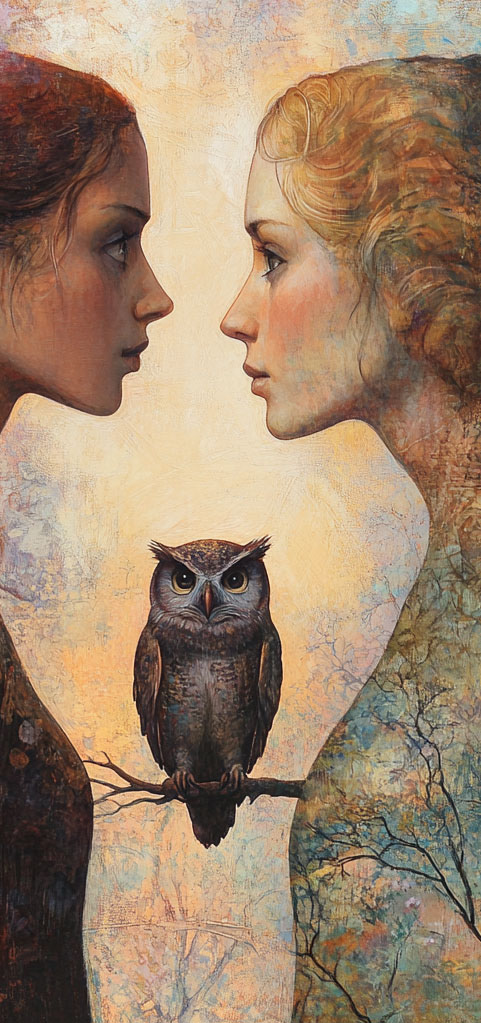In the deepest recesses of our psyche, fears and insecurities often lie dormant, influencing our trust in others and ourselves. Among women, in particular, these shadow aspects can lead to deep mistrust, reflected in archetypal patterns. These darker sides of our personality have a profound impact on our interpersonal relationships, as they often unconsciously shape our perceptions and behavior.
It is fascinating to observe how archetypes—symbolic figures that embody the darker aspects of the human psyche—play a role in our daily interactions. These archetypes not only mirror our own fears but also the collective challenges we face in relationships. In my own experience, I have often found that these hidden, often suppressed aspects of our personality have a fundamental influence on our ability to trust.
Yet, here lies a significant opportunity: If we have the courage to confront our shadows, we can break free from the patterns of mistrust that hold us back. This journey requires bravery, but it also offers an immense chance for self-realization. By facing our fears and revealing our vulnerabilities, we create space for deeper, more authentic connections with others.
In a time when superficial connections often overshadow the depth of interpersonal relationships, it is more important than ever to consciously engage with our own shadows. As a woman, it is crucial for me to recognize and let go of old patterns of mistrust, in order to build a supportive network instead. By being courageous and empathetic, we can grow together and strengthen each other.

What Does It Involve?
- Recognizing Inner Patterns: Having the courage to look deep within and identify the patterns that nurture mistrust.
- Addressing Hidden Fears: Speaking openly about our fears to disempower them.
- Acknowledging Your Own Worth: Developing self-esteem and recognizing yourself as worthy and lovable.
- Promoting Honest Communication: Communicating openly and authentically to build trust.
- Solidarity Instead of Competition: Prioritizing unity and mutual support over competition.
- Redefining Archetypes: Questioning and reshaping negative archetypal roles such as the Rival, the Betrayer, or the Outsider.
- Consciousness Work in Communities: Working together on personal and collective consciousness development.
- Taking Personal and Collective Responsibility: Taking responsibility for our own feelings and actions to heal the collective consciousness.
- Sharing Knowledge: Sharing experiences and insights with one another to learn from each other.
- Creating Safe Spaces: Establishing environments where everyone feels safe and supported.
- Nurturing Long-Term Networks: Consciously nurturing and building relationships and networks based on trust and support.
By taking these steps, we can initiate and promote a paradigm shift within ourselves and our communities. It is a continuous process of questioning old patterns and replacing them with new, supportive, and trusting relationships.
Exploring our shadows and rediscovering the power of trust is not an easy task, but it is worthwhile.
The Archetypes of Female Mistrust
The archetypes of female mistrust are symbolic figures that embody specific fears, insecurities, and shadow aspects that often arise in relationships between women. These archetypes reflect deeply ingrained patterns that nurture mistrust and can strain relationships. Here are some of the most prominent archetypes of female mistrust:
The Rival
This archetype embodies the belief that other women pose a threat. The Rival views the world through the lens of competition, where the goal is to be the “better” one—whether in terms of appearance, success, or relationships. The feeling that there is only room for one leads to jealousy, comparisons, and a lack of solidarity.
The Betrayer
The Betrayer represents the fear of broken loyalties. This archetype assumes that friendships and alliances can easily break down, often due to intrigue or breaches of trust. Mistrust toward other women grows because one expects that their kindness or confidentiality will eventually be betrayed.
The Queen of Manipulation
This archetype uses charm, power, or emotional manipulation to exert control over other women. The Queen of Manipulation mistrusts others because she is mistrustful herself and thus believes that others are also manipulative and dishonest. This figure reflects a deep fear of losing control and prevents authentic connections.
The Outsider
The Outsider feels excluded from the community or group, believing she doesn’t belong. This perception leads to deep mistrust toward the group and its members, as she believes others intentionally exclude or devalue her. This mistrust reinforces isolation and withdrawal from social contacts.
The Distrustful Mother
This archetype projects her own fears and insecurities onto other women, often as a protective mechanism. The Distrustful Mother is overly protective and tries to shield herself and others from potential dangers. However, this creates an atmosphere of mistrust, making open communication and trust difficult.
The Perfectionist
This archetype strives for unattainable perfection and believes that other women are constantly judging her. The Perfectionist mistrusts others because she thinks that every mistake or weakness will be exploited or judged. This attitude leads to excessive self-criticism and a sense of isolation, as true closeness and understanding are perceived as dangerous.
The Shadow Warrior
The Shadow Warrior is always on guard, expecting betrayal and hostility from other women. She frequently interprets actions and words negatively, believing that others want to harm her. This constant vigilance prevents trust from developing and fosters an atmosphere of conflict.
Spiritual Guidance on the Path to Self-Discovery
The shadows of the female psyche are often deep and complex, yet they also hold immense power for transformation. By dedicating yourself to these hidden parts of your being, you can not only strengthen your trust but also develop a deeper understanding of your emotions. Archetypes serve as guides that help you recognize and accept your inner parts. They reveal the resources within you and how you can activate them to build self-confidence. Through the process of exploring and acknowledging these archetypal patterns, you gain powerful insights into yourself. Emotions play a central role in this process; they are not just companions but also teachers. By acknowledging and understanding your inner tensions, you open the door to trust and healing. On this journey, community becomes a valuable anchor. The support of others can help you find the courage to navigate your shadows and discover the full depth of your female psyche.
Feel free to add your thoughts about this subject in the comments!
